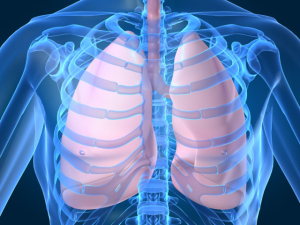Inhaling chemo brings drugs straight to lung cancer
by
Brendon Nafziger, DOTmed News Associate Editor | May 25, 2010

New delivery option
for cancer treatment
shows promise.
The deadliest cancer in the United States might one day be treated by breathing in a cocktail of cancer-fighting compounds.
Inhaling a potent mix of anticancer and gene therapy drugs shrinks lung cancer tumors while decreasing toxicity to other organs, a new study finds.
In mice, the combined drug treatment delivered through an aerosolized mist can shrink tumors by almost 97 percent, and produces up to four times less toxicity to healthy organs than traditional intravenous chemotherapy, according to the study to be published this week in the Proceedings of the National Academy of Sciences.
Breathing in the mist delivers the compounds directly to the lung tumors, while mostly sparing healthy tissue the often toxic side effects of anticancer treatments.
"After intravenous injection, the drug will go everywhere," Tamara Minko, a professor of pharmaceutics at Rutgers University in Camden, N.J. and lead author of the study, told DOTmed News.
"Some drugs will come to lungs, but a lot of drugs will be in other organs, like the liver, kidney and heart, which means the drug will be toxic to the whole organism."
The treatment might offer promise in battling lung cancer, the leading cause of cancer-related deaths in the United States, and the second-most common cancer overall, according to the National Cancer Institute (NCI). About 160,000 Americans died from the disease last year, which costs the U.S. nearly $10 billion in medical bills, according to the NCI.
The inhalation therapy combines doxorubicin, a chemotherapy drug, and gene therapy compounds called antisense oligonucleotides. These compounds help the chemo kill cancer cells by thwarting cancer's ability to pump out the drug or erect cellular defenses against treatment, Minko explained.
The inhalation was made possible by joining the compounds to liposomes - vesicles 200 nanometers-large or about one five-hundredth the size of a human hair. The resulting suspension could then be delivered with a nebulizer, a device that, often with ultrasonic energy, can turn medication into breathable vapor.
In the study, the researchers separated 60 mice into six groups of 10. Some groups received traditional intravenous chemotherapy, while others received the liposomal drugs intravenously (to make sure the liposomal attachments were not causing the therapeutic benefit). Another group inhaled chemotherapy alone, while two main treatment groups breathed two forms of the cocktail of anticancer drugs plus gene therapy compounds.
As Minko explained, mice that just got the chemo injected had their lung tumors shrink by only 14 percent. Inhalation of the DOX alone was about twice as effective, shrinking the tumors by 35 percent. But a combination of gene and anticancer almost eradicated the tumor, shrinking it by nearly 97 percent.
Side effects lessened, too, thanks to the inhalation treatment.
"The inhalatory delivery of drugs decreased the toxicity of DOX in liver, kidney, spleen and heart...2.9, 3.0, 2.4, and 3.8 times, respectively," Minko wrote later in an email.
Rutgers is patenting the inhalable mixture, Minko said.
The researchers are still trying to perfect the technique. While the inhaled drugs are less toxic for the whole animal, they're still somewhat toxic to healthy lung cells near the cancer. Minko said they're investigating other compounds for delivery.
"We hope other nanoparticles might deliver other drugs better," she said.
